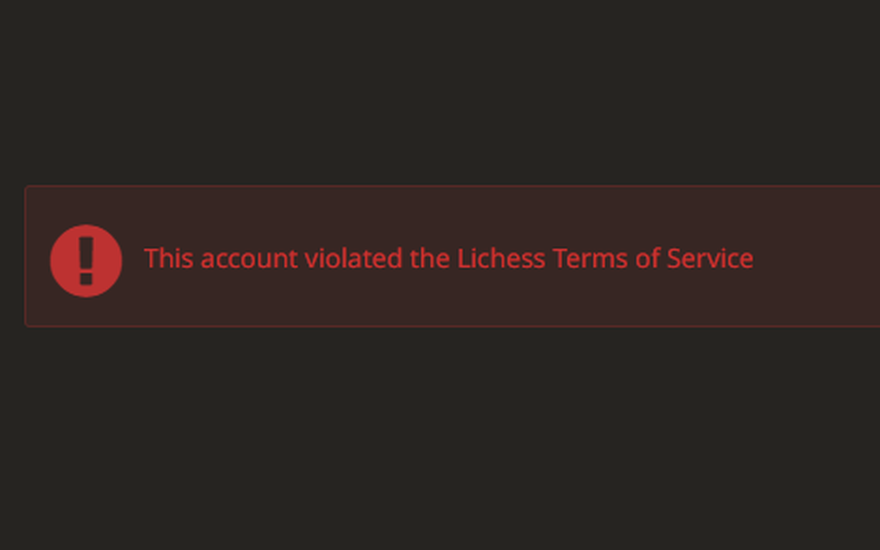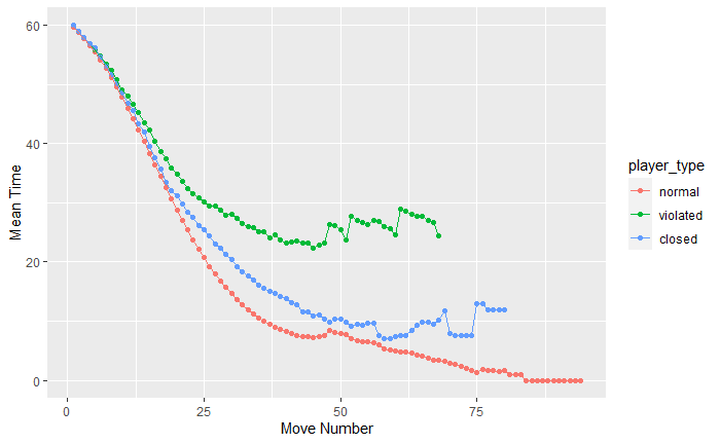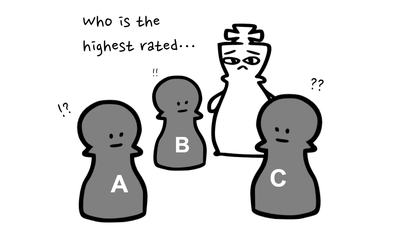
Cheater gameplay? - part 1
How do they differ in 1+0 Bullet gamesBefore reading this post
The games in this analysis were lichess-annotated 1+0 bullet games from April 2023. More about the data can be found at the lichess open database. Lichess does not annotate all their games in the database file, only a few games are annotated. Especially, 1+0 games with annotations compose less than 5% of the total 1+0 games. Annotations are done using Stockfish according to lichess. The analysis will not dig deeper into questioning the authenticity of the analysis.
Introduction
In this post, I will be focusing on how time management looks different. I will work on part 2 where I will dive deeper into the evaluations and material differences that happen during the games. However, there are many tricky analyses in that part so if there are any specific suggestions I would love to know. I will also try to go over some process that happens behind the scenes.
Classifying Account Types
Lichess has its profile for each player. For instance, my profile looks like the one below. I have not violated the terms of service nor closed my account. However, if you violate the Terms of Service, you get the red mark with the text "This account violated the Lichess Terms of Service." If you decide to close the account, no profile will appear, and it will just say, "This account is closed."
I decided to use some web scraping methods to gather information about players. However, gathering all information about players will result in increasing a lot of traffic which I didn't want to cause. I decided to choose players with more than 30 games in my database and gathered their information.
There is also a problem involving the time difference between my April 2023 game database and the current status of the player. This part is hard to coordinate. The best I can do is to update my game database to May 2023 and assume players who violated terms or closed accounts played in the same manner in April / May 2023. I will assume that the violated and closed accounts were still playing in the same manner back then.
Probably some of these accounts participated in some form of cheating. Some accounts might still be innocent. I will refer to these accounts as violated and closed in the analysis.
Winrate of violated/closed accounts
Do violated/closed accounts have a higher win rate than normal players? Yes. We can see that the win rate of violated and closed accounts are both higher than 60%. Normal players also have a win rate higher than 50% but as I said, the normal players are players with more than 30 games which affects the win rate.
Among these wins and losses, we can try to differentiate how they won or lost. As expected, violated or closed accounts have very low proportions of loss on time. Most likely this means they have no time management issues. As expected, they have a lot of wins from checkmate or opponents' resignations. Normal players have more wins on time but violated/closed players have much higher normal wins.
Time management by Move number
Now we should see how the players manage their time differently. The white dots are moves made by normal players. Red and Blue were made by violated/closed players. We can already see how winning on time happens often in these players. Most of the red and blue dots are populated upper-right side compared to the white dots. 
If you want a simpler graph showing the mean time left by the move number, this graph will do. Violated players on average have 20 seconds left even after 60 moves.

Other than the general usage of time, we can see the time advantage. For instance, if we are at Move 20, I have 40 seconds and you have 20 seconds, I have a 20-second time advantage. Closed account players had less advantage than violated players. Violated players had a constant time advantage over other players for most of their games. We can see that some people start with a 30-second time advantage or disadvantage but this is due to the berserk feature in lichess.
Time Spent on moves and the quality of moves
The following are the proportions of Time spent making moves for each type of player. This may look similar but they are largely different. The proportions of 0 seconds spent are 10% lower in normal players and the moves that spent 2 seconds are 10% higher in normal players.
| Time Spent | Normal | Violated | Closed |
|---|---|---|---|
| 0 | 13.4% | 25.5% | 24.4% |
| 1 | 42.4% | 44.9% | 41.9% |
| 2 | 29.3% | 18.6% | 19.3% |

Normal players take time when given a complicated position. More time spent on a move reflects their uncertainty resulting in a higher ratio of dubious moves, mistakes, and blunders. However, this general trend is not as apparent in violated/closed accounts. The blunder ratio is significantly lower in violated accounts.
We can also see the quality of moves by Time left. The following is the percentage of non-normal moves (dubious moves, mistakes, and blunders) made but the three types of players. Both violated and closed accounts have lower non-normal move percentages but for violated accounts, there is an uprise of bad moves in the last 10 seconds of the match.
Limitations and future posts
The clear limitation lies in the mismatched time frame of the classification of accounts and games played. The games were played in April 2023, when the classification of accounts was done in June 2023. When the June 2023 Database updates, I will move on to that dataset to be precise with my analysis. Furthermore, the number of classified players was a small portion compared to all players that played a game in April 2023. Maybe for future analysis, I will look for alternatives to slowly classify accounts in lichess without affecting the traffic. Thank you for reading this post. If there are any suggestions please leave a comment!
More blog posts by oortcloud_o

Linking top players based on openings
Using relatedness network on opening choices of top grandmasters
Which openings are related?
simulating opening connectivity graphs with known techniques
A short literature review
chess opening similarity and more